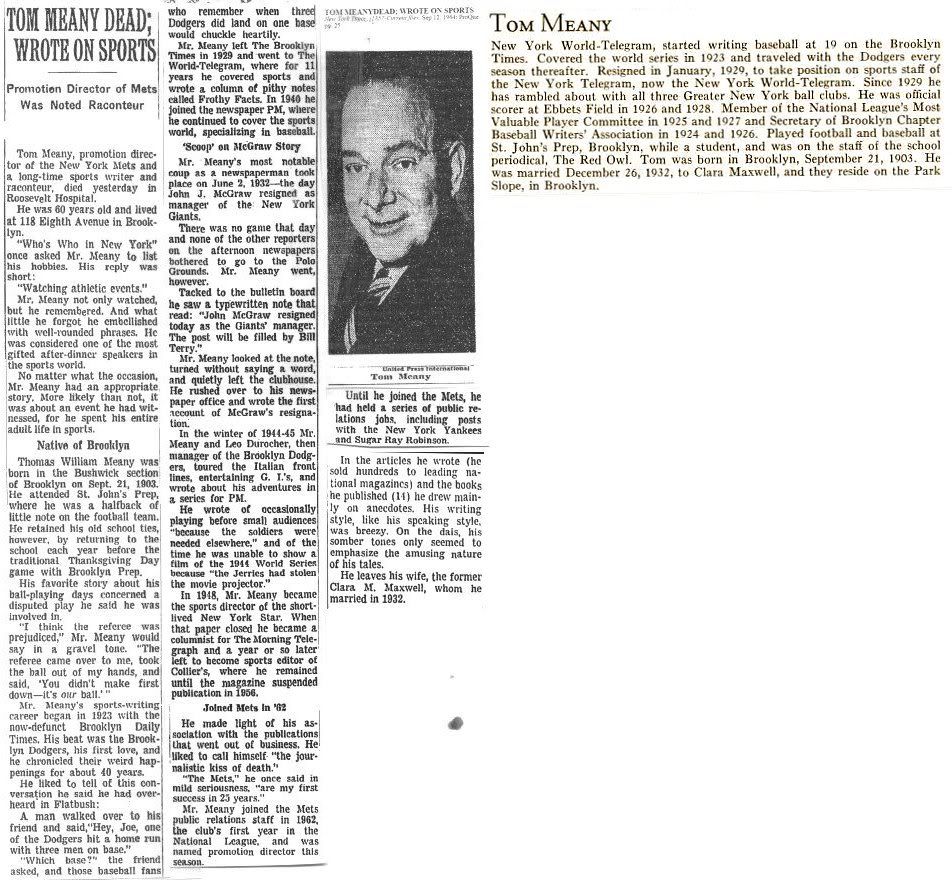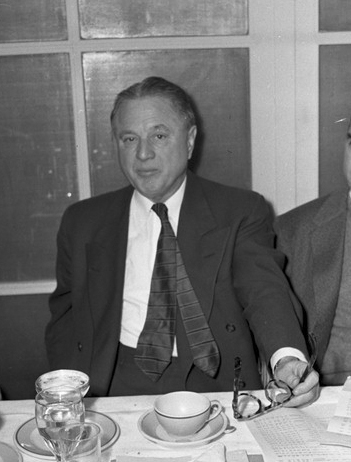|
The end of the Mets' championship run perhaps came not on the field of honor, but via decaptiation from behind. For little more than two years after losing their championship GM, manager and legendary Brooklyn Dodger vet Gil Hodges was felled by a heart attack. He had been similarly stricken during a September 1968 game, and subsequently gave up the cigarette habit that virtually all young men of his generation picked up in the military (if not sooner). But nicotine is a jealous lover, and as few as the vices were that the skipper reputedly entertained, he fell back in with her.
 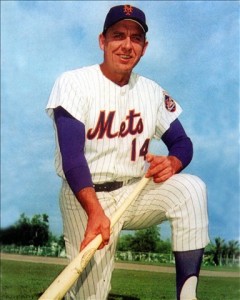
I've always associated the legend of Gil with that of my father --- both linked to Brooklyn, Catholic, taciturn, and impossibly strong, with handsome faces despite features that lent themselves to caricature --- and I suppose he was looked upon as a father, brother, son, or even surrogate husband to many in New York. Despite his Indiana roots, he was treated as a native, and made a year-round home in New York with his wife Joan and their kids. Some businesses sponsor a Little League team. Sometimes, an individual does. (Back in my home town, Joan Jett did.) Gil sponsored a whole league, which now remains named in his honor.

Symbolic of his duel citizenship are the two bridges named in his honor --- The Gil Hodges Bridge in Petersburg, Indiana, on Highway 57 over the White River (which I can't, for the life of me, find an online photo of) and, more familiar to most of us, the Marine Parkway Gil Hodges Memorial Bridge in New York, linking the Rockaway Peninsula in Queens to Floyd Bennett Field in Brooklyn, and symbolically linking the two boroughs for which he helped bring home a championship.

Bridges are appropriate tributes to Gil Hodges, who to a greater or lesser extent, was a bridge himself, linking boroughs, parts of the country, races, generations, eras, and people of good will.
A quick recap: Hodges, as many of us know, started his career as a catcher. He briefly came up before the war, and oddly enough, his lone appearance in the bigs in 1943 as a 19-year-old was at third base, a position he wouldn't return to for 14 years. Wartime service claimed his next two seasons, serving in the pacific theater as a marine and earning a Bronze Star and a commendation for courage under fire. He returned to the minors in 1946 with Newport News before sticking in the bigs in the watershed season of 1947.
The 1947 Dodgers are historically interesting in more ways than one, in that the pieces were largely there, but not yet in place. Jackie Robinson was at first, Duke Snider was a reserve, and Hodges was trying to hack it as a catcher. The Dodgers knew they had Roy Campanella coming up to catch, and that Robinson's athleticism belonged in the middle of the diamond, and they began transitioning Hodges to first, where he soon became a standardbearer at the position.
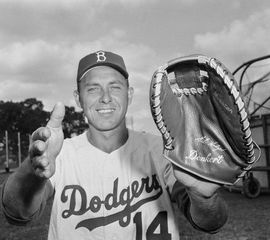
Hodges went on to have a 16+-season career, characterized by those enormous hands (note how the heel of his left hand won't disappear into his firstbaseman's mitt), defensive prowess, strong and silent leadership, and (again) his prodigious strength. The only player who hit more homers in the 1950s was his teammate Duke Snider. Not Mantle, not Matthews, not Mays. You can look it up.
He also invested in his community, or lent his name to somebody else who did.


(Gil Hodges Lanes on Strickland Avenue in Brooklyn.)
After heading west for four seasons with the Dodgers, he finished his career with two fading campaigns with the Mets. A few dozen games into the 1963 season, he walked away from the Mets to begin a second career as a manager with the lowly Washington Senators. Here he is walking around Yankee Stadium like he owns the place, because he does.
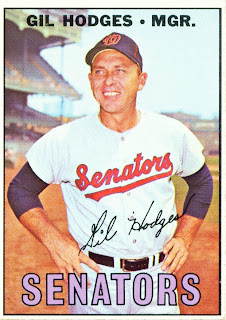
A common retort to the "Gil Hodges for the Hall of Fame" position is that, if he was such a great manager, if the 1969 Mets weren't a fluke, why didn't he do anything with the Senators? Well, he did!
| Season | Manager | Games | Wins | Losses | Win % | Place | | 1963 | Mickey Vernon and Ed Yost | 41 | 14 | 27 | .341 | 10 | | 1963 | Gl Hodges | 121 | 42 | 79 | .347 | 10 | | 1964 | Gl Hodges | 162 | 62 | 100 | .383 | 9 | | 1965 | Gl Hodges | 162 | 70 | 92 | .432 | 8 | | 1966 | Gl Hodges | 159 | 71 | 88 | .447 | 8 | | 1967 | Gl Hodges | 161 | 76 | 85 | .472 | 6 |
I'm not going to tell you that he singlehandedly made Chuck Cottier a defensive wizard at second or taught Claude Osteen to place his slider, but that is a team going in the right direction. We've long been able to distinguish the excellence of a well performing player surrounded by the bad-talent teammates he's surrounded with, but we've made relatively little effort to isolate the efforts of a manager statistically. All we seem to know is that managers who win championships are doing a great job. Well, I'm here to tell you that some managers on sixth-place teams are doing a good job also. Let's see how many games you win when your GM refuses to get you a thirdbaseman better than Ed Brinkman.
Nice sox, too.
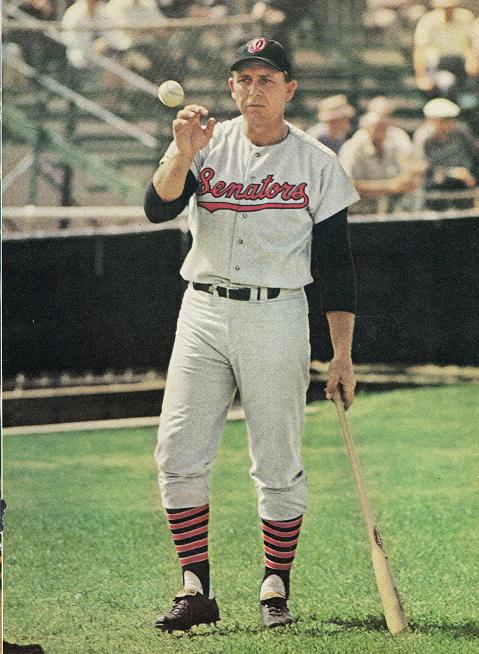
Well, you know where it goes from there. If you listened to last night's broadcast, you heard a little bit about a pitcher named Bill Denehy. The Mets, considering Hodges tenure in Washington merely an internship for his return to New York, sent Denehy to Washington for Hodges, and his leadership has long been cited as crucial for the most miraculous of championships. You believe what you wanna believe.


Glory is fleeting, and the end came on a golf course two and a half years later during a brief players' strike, while Hodges was on the links with his horrified coaching staff looking on. Decades later, Joe Pignatano would tearfully describe his longtime colleague going down hard before their eyes. Baseball writer Fred Girard began his column with "I don't really know how to do this."
Gil Hodges' remains lay in his adopted borough of Brooklyn, in Holy Cross Cemetery, at 3620 Tilden Avenue.

His grave is in the St. Catherine Section, Range B, Lot 191/193, under a simple marble monument that says nothing of his fame on the baseball field or his heroism on the battlefield. Space beside him remains reserved for his beloved Joan, now 40 years his widow.

|










